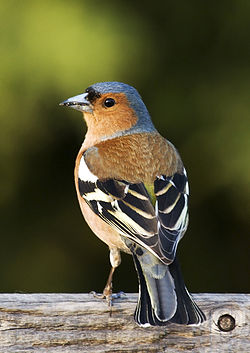Species
By the early 20th century, the genus was considered to include just three species, with the other species included by Linnaeus transferred to other genera. In 2016, it was proposed that the extremely rare Gran Canaria blue chaffinch subspecies F. teydea polatzeki be treated as a separate species, thus accepting a fourth species, F. polatzeki. [4] [5]
A major genetic, morphological, and behavioural study in 2021 then divided the former common chaffinch (Fringilla coelebs sensu lato) into five species, [6] so the genus is now accepted as containing eight species: [7]
| Image | Scientific name | Common name | Distribution |
|---|
 | Fringilla coelebs | Eurasian chaffinch | Europe, across Asia to western Siberia; migrating south in winter to north Africa and northern India |
 | Fringilla spodiogenys | African chaffinch | Northwestern Africa; nonmigratory |
 | Fringilla moreletti | Azores chaffinch | Azores; nonmigratory |
 | Fringilla maderensis | Madeira chaffinch | Madeira; nonmigratory |
 | Fringilla canariensis | Canary Islands chaffinch | Canary Islands; nonmigratory |
 | Fringilla polatzeki | Gran Canaria blue chaffinch | Gran Canaria in the Canary Islands; nonmigratory |
 | Fringilla teydea | Tenerife blue chaffinch | Tenerife in the Canary Islands; nonmigratory |
 | Fringilla montifringilla | Brambling | Northeastern Europe and northern Asia, migrating west and south in winter to western Europe, north Africa, northern India, northern Pakistan, China, and Japan |
|
The Eurasian chaffinch is found primarily in forest habitats, in Europe and western Asia; the other species formerly treated as subspecies of it occur in North Africa and Macaronesia; the blue chaffinches are island endemics; and the brambling breeds in the northern taiga and southern tundra of Eurasia. [8]
The eight species are all broadly similar size, 14–18 centimetres (5.5–7.1 in) in length, with brambling the smallest, and Tenerife blue chaffinch the largest; they are all similar in shape. [9] [8] They have a bouncing flight with alternating bouts of flapping and gliding on closed wings. [10] They are not as specialised as other finches, eating both insects and seeds. While breeding, they feed their young on insects rather than seeds, unlike other finches. [8]








